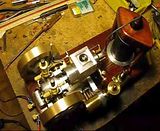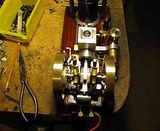You are using an out of date browser. It may not display this or other websites correctly.
You should upgrade or use an alternative browser.
You should upgrade or use an alternative browser.
Brian Builds the Kerzel Hit and Miss I.C.
- Thread starter Brian Rupnow
- Start date

Help Support Home Model Engine Machinist Forum:
This site may earn a commission from merchant affiliate
links, including eBay, Amazon, and others.
- Joined
- Aug 25, 2007
- Messages
- 3,890
- Reaction score
- 715
Nice work, Brian. Watching your video, I'm wondering if the flywheel weight is too high. It sounds like it fires several times to get the engine up to enough speed for the governor to kick in. Just throwing this out there as a question. Can you try it with the flywheel opposite the governor removed?
Chuck
Chuck
Thanks guys!!! Chuck--I took the non-governor flywheel off tornight just for giggles. It didn't run nearly as well. It needs the weight of both flywheels to keep it moving between hits. I tried a different pair of springs than the ones I had, but they weren't different enough to make much difference. I tried it with just one spring, but it goes into miss mode too easily with only one spring, and the engine doesn't get going fast enough to keep itself running. I changed the valve timing a bit to see if I could perhaps get the engine to slow down a little, before it explodes from over revving.--tuneing is ongoing.
chuck foster
Well-Known Member
- Joined
- Jul 11, 2007
- Messages
- 704
- Reaction score
- 2
brian another thing to look at is the compression ratio.
i have a fairbanks model that when built to the drawings it has way to high of a compression ratio.
at top dead center there was .090" between the top of the piston and the cylinder head.
now this engine would run but it had to run really fast, about 700 to 800 rpm's. so i shortened the connecting rod by .750"
now it will run so slow that just before it fires at top dead center you can see the flywheels almost stop.
with the higher compression ratio it takes allot more rpm's to over come the compression.
i hope what i just typed makes sense???
chuck
i have a fairbanks model that when built to the drawings it has way to high of a compression ratio.
at top dead center there was .090" between the top of the piston and the cylinder head.
now this engine would run but it had to run really fast, about 700 to 800 rpm's. so i shortened the connecting rod by .750"
now it will run so slow that just before it fires at top dead center you can see the flywheels almost stop.
with the higher compression ratio it takes allot more rpm's to over come the compression.
i hope what i just typed makes sense???
chuck
Aermotor--I have removed the spring at the outer end of the Kerzel arm---it was not in the original plan, and wasn't necessary on this engine. This is a fairly low compression engine, along the lines of 5 or 6 to 1 compression. I have to play with the valve and ignition timing untill I get it ticking over slowly. It runs well at a higher RPM and does go in and out of hit and miss mode as you can see in the video. I agree, I probably need lighter springs, but untill I get the engine to run slowly on its own, it Definitly is not going to run slowly in hit and miss mode.
Generatorgus
Senior Member
- Joined
- Feb 25, 2010
- Messages
- 362
- Reaction score
- 166
Brian, I'm not at all familiar with what it takes to slow one of these little guys down. On the full size hit n miss my buddy is expert, people bring engines to him, even from fairly long distance, to slow em down.
Some of his tricks:
Compression: ad a head gasket or two
remove a ring or two
Fuel: Richen it up or choke it a little
Governor: lighter springs
remove one spring or sometimes both, even remove one weight
stretch one or both springs a little
if one spring is too little to latch up, cut a coil or two off
Spring mods are his first choice
Maybe none of the above, sometimes they just don't want to slow down. Truth is they weren't made to run slow. Hang in there, you'll figure it out. Nice build.
I like slow running throttlers myself, nice even sound.
Just my couple of pennies worth.
GUS
Some of his tricks:
Compression: ad a head gasket or two
remove a ring or two
Fuel: Richen it up or choke it a little
Governor: lighter springs
remove one spring or sometimes both, even remove one weight
stretch one or both springs a little
if one spring is too little to latch up, cut a coil or two off
Spring mods are his first choice
Maybe none of the above, sometimes they just don't want to slow down. Truth is they weren't made to run slow. Hang in there, you'll figure it out. Nice build.
I like slow running throttlers myself, nice even sound.
Just my couple of pennies worth.
GUS
I have been tweaking---fiddling---adjusting!!! I have the engine going in and out of hit and miss mode, but its away too fast. If I slow it down and use weaker governor springs, then when it does go into miss mode and then come back out of miss mode, even though the exhaust valve begins to function again, the engine won't "catch" and fire again, instead it just runs down and quits. So---I have been trying to get the engine to run consistently at a much lower RPM. Adjusting the ignition timing has some effect on this, but no amount of advancing or retarding the ignition got me to the lower RPM I desired. the next obvious step was to monkey with the valve timing, and it has yeilded signifigant results in terms of engine speed. Today I go out in search of weaker governor springs
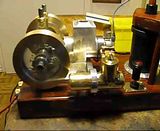

Brian, can't remember whether the latest carb had a throttle or not, but could you put a restricter in there so it's not wide open all the time and weaken the mixture accordingly. What is the compression ratio approximately? I would have said something like 5 or 6:1 should make the engine more docile. The inertia in the flywheels alone has to be enough to compress the mixture when it wants to hit again so you want a low compression ratio. Maybe the flywheels could do with being heavier to slow it down too. How much friction is there in the system? Again, without going through the massive log, what sort of piston ring did you use? I know it's an i.c. but the same principle must apply still to get friction as low as possible. With the exhaust valve held open does the engine spin over freely? With a hit & miss where you want the engine to coast happliy before it hits again, friction must be a big consideration.
You've probably thought of all of this but just thought I'd chip in with some of my initial thoughts.
You've probably thought of all of this but just thought I'd chip in with some of my initial thoughts.
NickG said:Brian, can't remember whether the latest carb had a throttle or not, but could you put a restricter in there so it's not wide open all the time and weaken the mixture accordingly. What is the compression ratio approximately? I would have said something like 5 or 6:1 should make the engine more docile. The inertia in the flywheels alone has to be enough to compress the mixture when it wants to hit again so you want a low compression ratio. Maybe the flywheels could do with being heavier to slow it down too. How much friction is there in the system? Again, without going through the massive log, what sort of piston ring did you use? I know it's an i.c. but the same principle must apply still to get friction as low as possible. With the exhaust valve held open does the engine spin over freely? With a hit & miss where you want the engine to coast happliy before it hits again, friction must be a big consideration.
You've probably thought of all of this but just thought I'd chip in with some of my initial thoughts.
Compression ratio is 5:1 flywheels are very heavy--bronze outer rims. Spins freely with exhaust valve held open. Piston ring is Viton o-ring. No throttle on current carb.
Hmm, if all of that seems in order I guess the only real way to slow it down then is for it to draw less air / fuel mixture. If the timing is right there's no point messing with that, it will just cause it to run roughly, the fuel mixture should be the right so think you need to restrict the air flow.
Nick
Nick
putputman
Senior Member
- Joined
- Nov 22, 2008
- Messages
- 600
- Reaction score
- 55
Brian, you are very close to getting your engine running the way you want. There is one area that hasn't been addressed yet. That is the drag on your piston. If you go back to your post #192, where you used the o-ring manufacturers recommendation on o-ring groove dimensions, you will see they ask for .010 - .018 squeeze on the o-ring cross section. That is probably a good and necessary squeeze on a o-ring used in a hydraulic cylinder, but it is way too much for a model engine.
A typical 1/16 o-ring has a .070 cross section. When I cut the o-ring groove in a piston, I cut the depth to about .001 less than the cross section. This provides very little drag when the engine is free wheeling, but when the engine fires, the pressure compresses the o-ring against the back surface of the groove and provides plenty of squeeze. I have use this procedure on several of my engines and it has worked well for me.
I made a video for you showing how little drag there is on one of my engines that uses a Viton o-ring. As you can see when I spin the flywheel it bounces back and forth several times. Also when I spin it with the exhaust valve open, it spins free for many revolutions. This engine is using one cast iron ring that wound not seat, and one Viton o-ring in the second groove.
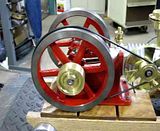
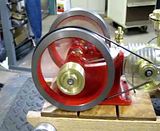
You might compare this with your engine to see if it is this free or if there is enough drag to prevent it from running in a hit & miss mode. You should be able to run much slower without stalling out the engine. This you achieve with lighter springs.
You should be able to re-cut the grooves in your existing piston. If not, pistons are pretty quick & easy to make.
I sounds to me that your valves and timing are working well and I think you have done all you can with them.
I admire your perseverance and feel your pain.
A typical 1/16 o-ring has a .070 cross section. When I cut the o-ring groove in a piston, I cut the depth to about .001 less than the cross section. This provides very little drag when the engine is free wheeling, but when the engine fires, the pressure compresses the o-ring against the back surface of the groove and provides plenty of squeeze. I have use this procedure on several of my engines and it has worked well for me.
I made a video for you showing how little drag there is on one of my engines that uses a Viton o-ring. As you can see when I spin the flywheel it bounces back and forth several times. Also when I spin it with the exhaust valve open, it spins free for many revolutions. This engine is using one cast iron ring that wound not seat, and one Viton o-ring in the second groove.


You might compare this with your engine to see if it is this free or if there is enough drag to prevent it from running in a hit & miss mode. You should be able to run much slower without stalling out the engine. This you achieve with lighter springs.
You should be able to re-cut the grooves in your existing piston. If not, pistons are pretty quick & easy to make.
I sounds to me that your valves and timing are working well and I think you have done all you can with them.
I admire your perseverance and feel your pain.
Similar threads
- Replies
- 413
- Views
- 38K
- Replies
- 356
- Views
- 54K




